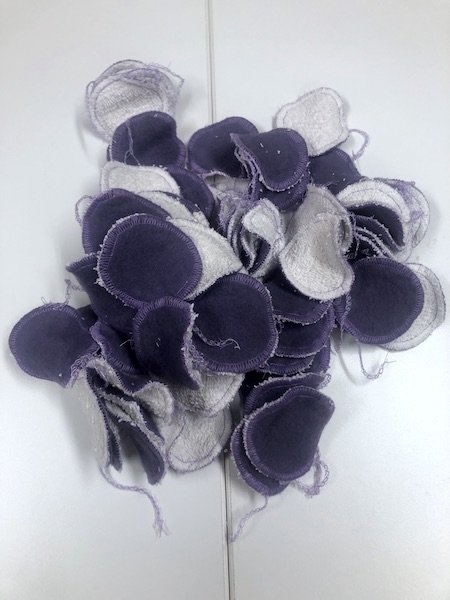Making T-Shirts
T-shirt class went very well. I had six students, including one from the Serger 101 class at the beginning of January, three who had been in my serger classes last summer, and two new students. One of the new students really should have taken the Serger 101 class because she was not familiar with her machine—and she acknowledged that—but she managed. Thankfully, all the machines were well behaved.
I am glad I structured the first class the way I did. I started with an overview of different kinds of knit fabrics and passed out samples for each student to take home. The quilt store owner had ordered a bolt of Laguna Cotton for me, so the students had quality fabric to work with in class, but we also talked about what they could expect to find online and at Joann Fabrics. It’s unrealistic to expect a quilt store owner to carry a wide selection of garment fabrics, and this owner knows that people may be buying garment fabric elsewhere.
We moved on to discussing patterns and pattern tracing. I had downloaded my pattern, printed it, and taped it together at home. One of the students had taken hers to Kalispell Copy and had them print it on their large-format printer, so everyone was able to see the two options. We talked about tracing paper and Pellon Easy-Pattern. I showed them how to use a dressmaker’s curve and why it’s best to cut out knits using a rotary cutter rather than shears.
I had cut out the pieces for a child’s T-shirt before class and brought my machine to class with me. I demonstrated how to serge the shoulder seams and add either clear elastic or 1/4” ribbon to stabilize them. I do have an elasticator foot for my serger, but I pointed out that on my serger, my regular presser foot has an adjustable opening for feeding elastic/ribbon. We checked everyone’s machines to see if others had that option.
I laid out the front/back, now serged together at the shoulders, and we talked about the relationship between armscyes and sleeve caps and how to pin in the sleeve using small Wonder Clips. I love that some of my knitting design experience has transferred so nicely to sewing. When I serged the first sleeve, part of the seam was a bit wonky, which gave me a chance to show them how to remove that part of the seam and re-do it. (Everything can be a learning opportunity.) I made a neckband, showed them how to divide it into fourths and clip it into the neck opening, and attached it. I serged the two side seams. The T-shirt was done except for the hems. I promised to bring my old coverstitch machine to next month’s class so they could try it out and hem their finished T-shirts.
That was the first half of the class. During the second half, everyone traced their patterns and some students even got their pieces cut out. Others wanted to take the fabric home and wash it, first. I had told them at the outset that there might be homework. Everyone went home happy and satisfied and I expect to see a batch of T-shirts at next month’s class. Next month, we’re going to trace an existing shirt and draft a pattern from it.
And some of them are already asking about a leggings class.
**************************************************
I decided to cut out the rest of the circles for the makeup pads before sorting tax stuff. I serged the rest of them yesterday morning before class so I could take them with me to sewing today.
Securing and trimming serger tails will be a good activity to do while sitting and visiting. I might throw this batch in the washer and dryer when it’s done to get rid of more of that lint.
The husband bought a new Honda generator for his other truck and asked if I could make a cover for it. I made a cover for the first generator out of some 500D Cordura. That one has held up well. I need more Cordura, though, so I ordered some from Seattle Fabrics on Monday. Their website notes that that they will be opening to the public again soon. That news makes me happy. The store has been closed to walk-in traffic for almost two years. I got a shipping notice within a few hours of submitting the order on the website, so I expect the Cordura to arrive soon.
The husband also ordered a new scan tool. This is a small tablet that hooks up to a vehicle’s computer and reads and diagnoses error codes. Scan tools range from very simple ones that just spit out the code to sophisticated systems that come with expensive subscriptions to a database with detailed information on virtually every make and model of vehicle. I’m not sure he’s at the expensive subscription level yet, but he’s close, thanks in part to The Diva. I am all for anything that makes it easier for him to work on my car.

